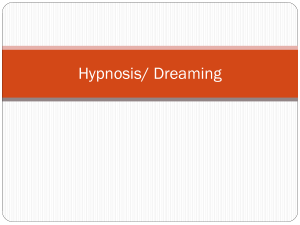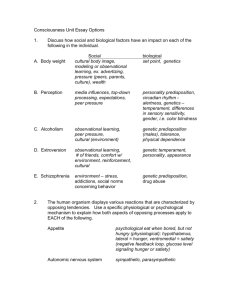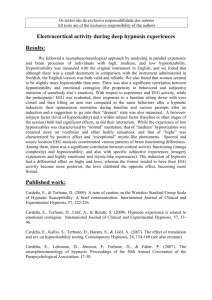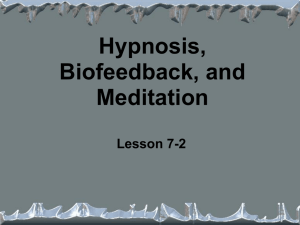What Is Hypnosis? Hypnosis Applications, Effects and Myths How
advertisement
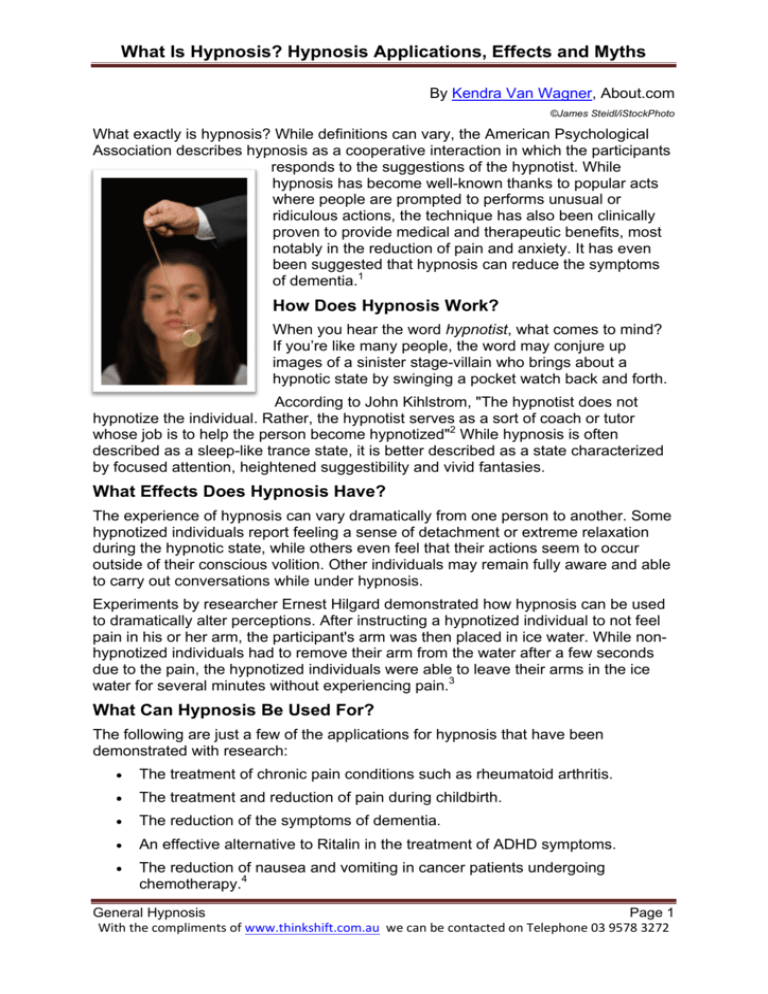
What Is Hypnosis? Hypnosis Applications, Effects and Myths By Kendra Van Wagner, About.com ©James Steidl/iStockPhoto What exactly is hypnosis? While definitions can vary, the American Psychological Association describes hypnosis as a cooperative interaction in which the participants responds to the suggestions of the hypnotist. While hypnosis has become well-known thanks to popular acts where people are prompted to performs unusual or ridiculous actions, the technique has also been clinically proven to provide medical and therapeutic benefits, most notably in the reduction of pain and anxiety. It has even been suggested that hypnosis can reduce the symptoms of dementia.1 How Does Hypnosis Work? When you hear the word hypnotist, what comes to mind? If you’re like many people, the word may conjure up images of a sinister stage-villain who brings about a hypnotic state by swinging a pocket watch back and forth. According to John Kihlstrom, "The hypnotist does not hypnotize the individual. Rather, the hypnotist serves as a sort of coach or tutor whose job is to help the person become hypnotized"2 While hypnosis is often described as a sleep-like trance state, it is better described as a state characterized by focused attention, heightened suggestibility and vivid fantasies. What Effects Does Hypnosis Have? The experience of hypnosis can vary dramatically from one person to another. Some hypnotized individuals report feeling a sense of detachment or extreme relaxation during the hypnotic state, while others even feel that their actions seem to occur outside of their conscious volition. Other individuals may remain fully aware and able to carry out conversations while under hypnosis. Experiments by researcher Ernest Hilgard demonstrated how hypnosis can be used to dramatically alter perceptions. After instructing a hypnotized individual to not feel pain in his or her arm, the participant's arm was then placed in ice water. While nonhypnotized individuals had to remove their arm from the water after a few seconds due to the pain, the hypnotized individuals were able to leave their arms in the ice water for several minutes without experiencing pain.3 What Can Hypnosis Be Used For? The following are just a few of the applications for hypnosis that have been demonstrated with research: The treatment of chronic pain conditions such as rheumatoid arthritis. The treatment and reduction of pain during childbirth. The reduction of the symptoms of dementia. An effective alternative to Ritalin in the treatment of ADHD symptoms. The reduction of nausea and vomiting in cancer patients undergoing chemotherapy.4 General Hypnosis Page 1 With the compliments of www.thinkshift.com.au we can be contacted on Telephone 03 9578 3272 What Is Hypnosis? Hypnosis Applications, Effects and Myths Control of pain during dental procedures. Elimination or reduction of skin conditions including warts and psoriasis. Alleviation of symptoms association with Irritable Bowel Syndrome.5 Can You Be Hypnotized? While many people think that they cannot be hypnotized, research has shown that a large number of people are more hypnotizable than they believe. Fifteen percent of people are very responsive to hypnosis.6 Children tend to be more susceptible to hypnosis.7 Approximately ten percent of adults are considered difficult or impossible to hypnotize.8 People who can become easily absorbed in fantasies are much more responsive to hypnosis.2 If you are interested in being hypnotized, it is important to remember to approach the experience with an open mind. Research has suggested that individuals who view hypnosis in a positive light tend to respond better.9 Theories of Hypnosis One of the best-known theories is Hilgard’s neo-dissociation theory of hypnosis. According to Hilgard, people in a hypnotic state experience a split consciousness in which there are two different streams of mental activity. While one stream of consciousness responds to the hypnotist’s suggestions, another dissociated stream processes information outside of the hypnotized individual’s conscious awareness.3 Hypnosis Myths Myth 1: When you wake up from hypnosis, you won’t remember anything that happened when you were hypnotized. While amnesia may occur in very rare cases, people generally remember everything that occurred while they were hypnotized.5 However, hypnosis can have a significant effect on memory. Posthypnotic amnesia can lead an individual to forget certain things that occurred before or during hypnosis. However, this effect is generally limited and temporary. Myth 2: Hypnosis can help people remember the exact details of a crime they witnessed. While hypnosis can be used to enhance memory, the effects have been dramatically exaggerated in popular media. Research has found that hypnosis does not lead to significant memory enhancement or accuracy,10 and hypnosis can actually lead to false or distorted memories.11 Myth 3: You can be hypnotized against your will. Despite stories about people being hypnotized without their consent,12 hypnosis requires voluntary participation on the part of the patient.5 Myth 4: The hypnotist has complete control of your actions while you’re under hypnosis. General Hypnosis Page 2 With the compliments of www.thinkshift.com.au we can be contacted on Telephone 03 9578 3272 What Is Hypnosis? Hypnosis Applications, Effects and Myths While people often feel that their actions under hypnosis seem to occur without the influence of their will, a hypnotist cannot make you perform actions that are against your values or morals.3 Myth 5: Hypnosis can make you super-strong, fast or athletically talented. While hypnosis can be used to enhance performance,13 it cannot make people stronger or more athletic than their existing physical capabilities. References 1 University of Liverpool (2008, July 29). Hypnosis Shown To Reduce Symptoms Of Dementia. Science Daily. Found online at http://www.sciencedaily.com/releases/2008/07/080728111402.htm 2 Kilhstrom, J. F. (2001). Hypnosis and the psychological unconscious. In Howard S. Friedman (Ed.), Assessment and therapy: Specialty articles from the Encyclopedia of Mental Health. San Diego, CA: Academic Press. 3Hilgard, E. R. (1986). Divided consciousness: Multiple controls in human thought and action. New York: Wiley. 4 Barrett, D. (2001). The power of hypnosis. Psychology Today. Found online at http://psychologytoday.com/articles/index.php?term=20010101000034&page=1 5 Mayo Clinic. Hypnosis: Another way to manage pain, kick bad habits. Found online at http://www.mayoclinic.com/health/hypnosis/SA00084 6 Hilgard, E. R. (1982). Hypnotic susceptibility and implications for measurement. International Journal of Clinical and Experimental Hypnosis, 30, 394-403. 7 Kohen, D.P., & Olsen, K. (1993). Hypnotherapy with children. In J.W. Rhue, S.J. Lynn & I. Kirsch (Eds.), Handbook of clinical hypnosis. Washington, DC: American Psychological Association. 8 Register, P.A., & J.F. Kilhstrom. (1986). Finding the hypnotic virtuoso. International Journal of Clinical and Experimental Hypnosis, 34, 84-97. 9 Kirsch, I. (1996). Hypnotic enhancement of cognitive-behavioral weight loss treatments: Another meta-reanalysis. Journal of Consulting and Clinical Psychology, 64, 517-519. 10 Nash, M.R. (2001, July). The truth and the hype of hypnosis. Scientific American, 285, 46-55. 11 Lynn, S. J. & Nash, M.R. (1994). Truth in memory: Ramifications for psychotherapy and hypnotherapy. American Journal of Clinical Hypnosis, 36, 194-208. 12 Barrus, A. (n.d.). Students hypnotized over the phone. BYU-I Scroll Online. Found online at http://www.byui.edu/scroll/archive/20050913/campus2.html 13 Morgan, W.P. (1993). Hypnosis and sport psychology. In J.W. Rhue, S.J. Lynn, & I. Kirsh (Eds.), Handbook of clinical hypnosis. Washington, DC: American Psychological Association. General Hypnosis Page 3 With the compliments of www.thinkshift.com.au we can be contacted on Telephone 03 9578 3272




